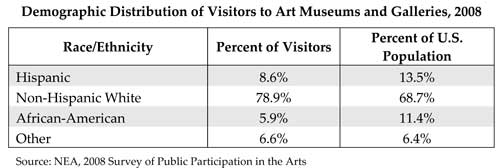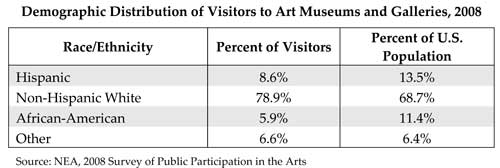July
2010
July 13, 2010
Changing Demographics Will Affect the Future of Museums
By 2050, the United States will become a majority-minority country. African-Americans, Latinos, Asian-Americans and Pacific Islanders collectively will become the new majority in the country, while non-Hispanic whites will comprise less than 50% of the population.
These population projections are very different from the current profile of museum attendees. In 2008, non-Hispanic whites made up 68.7% of the population, and accounted for 78.8% of all art museum visitors. Hispanics made up 13.5% of the population, accounting for 8.6% of all art museum visitors. Similarly, African-Americans made up 11.4% of the population and accounted for 5.9% of all art museum visitors. (See tables.)
As the minority becomes the majority, how can museums encourage increased participation and remain relevant to their communities? The Center for the Future of Museums has commissioned a report, Demographic Transformation and the Future of Museums, that examines these issues.


The report identifies three points about the minority population about which museums should be aware and provides case studies to address these points.
- There is diversity within racial and ethnic groups. The attitudes and opinions of foreign-born immigrants can be very different from those of their American-born brethren. Through acculturation and intermarriage, American-born ethnic minorities have the potential to become more muted in their sense of ethnic identity.
- Many highly diverse cities are composed of separate enclaves determined by race, ethnicity and social class. Institutions and public places that serve as “cosmopolitan canopies”—allowing people from different backgrounds to mingle and interact—are rare. Museums and other cultural organizations have played a significant role in providing such canopies, allowing dialogue between disparate groups in a safe environment.
- Attitudes about race and ethnicity are not fixed. Members of the millennial generation have embraced diversity to such a great extent that they do not describe their museum-going experiences through the lens of race and ethnicity. Instead, experiences are described in terms of modes of participation and interactivity.
The authors of this report recommend that museums prepare for demographic changes through better research and data collection about the population of their local communities. This can be accomplished by partnering with colleges and universities, businesses, local governments and foundations interested in fostering a robust civic culture and creative economy. Museums can encourage minorities into museum careers and can program participatory and social activities that attract younger and more diverse audiences.
For more information, read the full report, Demographic Transformation and the Future of Museums.
In this Issue
State to State
- North Dakota: Artist in Residency Program
- New Mexico: T.I.M.E.
- Maryland: Traditional Small Business Recognition Program
- Alaska: New Visions Grant
- Michigan: Retention and Engagement Youth Grant Program
Legislative Update
Executive Director's Column
Research on Demand
Did You Know?
SubscribeSubscribe
×
To receive information regarding updates to our newslettter. Please fill out the form below.
